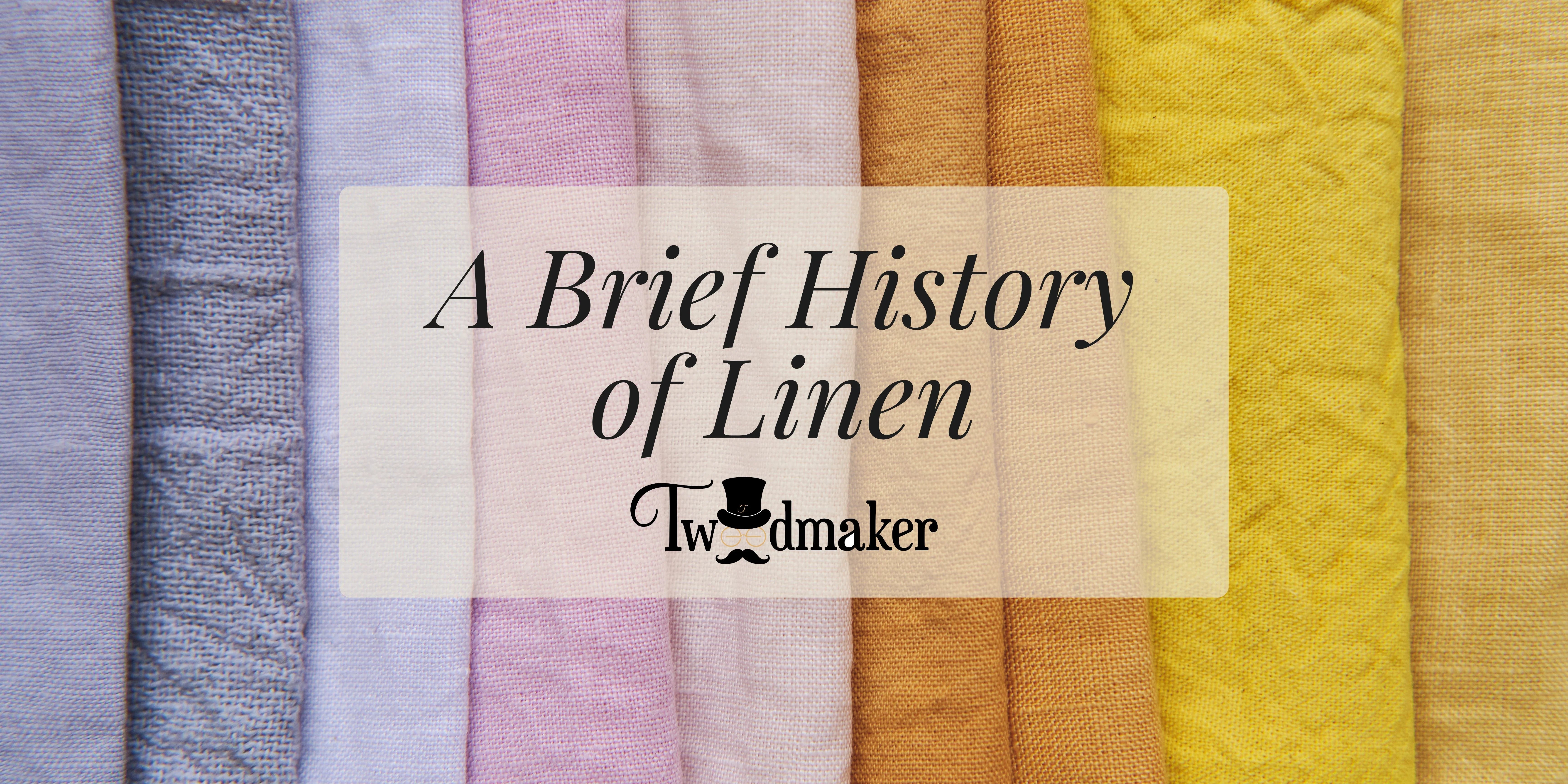
Linen is one of the most popular fabrics today. From crisp white linen shirts to lightweight linen trousers and suave linen suits, this fabric is used to create superior quality products.
But linen isn’t anything new. It has been around for millennia. And yet, it remains one of the top quality, most durable, stylish and functional materials to be used in clothing, especially in suits.
Let’s explore what linen is, where it comes from, its impressive history, and why it works so well for suits.
Table of content
What Is Linen?
Linen is a fabric that’s made from the fibres and stems of the flax plant.
While linen appears similar to cotton, it is actually far more difficult and costly to produce. There are a number of time-intensive, resource-intensive, and finicky steps that come from turning flax stems into linen, including fibre separation, breaking, combing, spinning, reeling, and drying. As a result, linen is typically a less common and more expensive choice for suits.
However, linen is a particularly desirable fabric for hot and humid climates. Unlike cotton, which tends to retain water for long periods, linen dries quickly and helps to remove sweat and heat on warmer days.
Types of Linen
There are several types of linen. While they all come from flax fibre, variations are produced by different weaving methods, including:
However, due to coming from the flax stems, linen has unique properties when it comes to moisture wicking, making it ideal for wear in warmer climates and ensuring the linen suit is still a staple in many a gentleman’s wardrobe.
- Damask linen: Ornate and delicate, formed on a jacquard loom for a result similar to that of embroidery.
- Plain-woven linen: Commonly used to make towels such as dish towels, hand towels, and cotton towels.
-
Loosely-woven linen: A highly absorbent form of linen, yet the least durable. Commonly used to make reusable diapers and napkins.
-
Sheeting linen: Linen clothing is usually made from sheeting linen due to its untextured soft surface and close weave. This linen fabric usually has a higher thread count than other types.
Where Does Linen Come From?
As one of the oldest produced textiles in human history, it’s possible that its origins may stem back even farther than historians know.
However, from what we do know, it dates back as far as prehistoric Europe and has stood the test of time, as it’s still used today.
Prehistoric Europe
It’s thought that linen dates back to prehistoric times, with the Neolithic peoples in Europe making textiles from linen as many as 36,000 years ago.
There is also evidence of linen use in ancient dwellings in Switzerland approximately 10,000 years ago. Archaeologists believe that linen was first domesticated in ancient Mesopotamia, reserved primarily for the ruling class.
Ancient Egyptian, Greek and Roman Empires
Thanks to linen’s cooling and moisture-wicking properties, it was widely used in the hotter climate of Ancient Egypt. It quickly became one of the most valuable and popular fabrics, and was even used as a type of currency.
Linen was also used to create the burial shrouds and wrappings for Ancient Egyptian mummies. Even today, much of the flax linen used in Egyptian tombs is well preserved, demonstrating the true durability of this material!
The Ancient Greeks also made use of linen, particularly for homewares and garments.
But up until the Roman Empire, linen wasn’t actually called linen. Instead, it was known as flax, due to its plant origins. The Romans named it “linum usitatissimum,” or “most useful flax.”
Middle Ages
By the Middle Ages, linen was a global phenomenon. Its versatility, comfort, and cooling properties reached countries like China, India, Persia, and even Tweed’s motherland — Scotland.
In the colder parts of Europe, linen was used to make undergarments worn underneath wool clothing. And that’s where the terms “lingerie” and “linen” come from!
Renaissance
During the Renaissance, linen was particularly popular amongst the wealthy. It was used for bedding, as well as various types of clothing, including shirts, shifts, and chemises.
18th Century
Around the seventeen hundreds, Ireland became the centre of linen production in Europe. The city of Belfast was then known as “Linenopolis”, due to its thriving linen trade. White and off-white linen suits were particularly popular around Europe at this time, worn mainly in the summer months.
Linen remained popular throughout the colonial era, but as cotton production became cheaper and easier, the use of linen slowly declined.
19th Century
In the 19th century, linen was commonly worn by British soldiers stationed in tropical colonies. They were practical for keeping them cool in the hot, humid climates that they weren’t necessarily used to, becoming a signature look for the Brits.
20th Century
Throughout the 20th century, linen suits were donned by the Hollywood elite of America. Some of the biggest actors of the time were often seen sporting a linen number, catapulting the fabric into the public eye and associating it with glamour and sophistication.
Linen Today
Today, linen remains a key (though less common) fabric. While it is more expensive to produce, consumers are recognising the value in wearing a practical yet stylish fabric over cheaper alternatives.
Linen remains a popular fabric for suits and is still considered to be a chic choice, with many celebrities spotted wearing it in the summer months.
What Is Linen Made of?
As we touched on above, linen is made from the flax plant, specifically, the cellulose fibre found in the stems of flax plants. Flax stems have a woody, reedy interior, with a fibrous, stringy exterior.
This plant fibre gives a number of practical properties to linen fabric, including:
- Lightweightedness
- Durability
- Breathability
- Comfortability
- Versatility — i.e. it can be dyed various colours
If you’re wondering how to wash linen, it’s best to check the manufacturer's instructions on the care label of your linen item. Delicate linen should usually be hand-washed, while more durable fabrics can be machine-washed. It’s recommended to wash your linen in either cold or tepid water.
Many will want to know — does linen shrink? It can shrink if exposed to too much heat, which is why it’s best to wash in cooler temperatures and to avoid machine drying.
How Is Linen Made?
Curious to know how linen is made? Here’s a step-by-step outline:
1. Planting, Growing, and Harvesting Flax
The flax plant is typically sown with machines during the cooler part of the year. Herbicides and tilling are often used to control weeds and maximise flax crop yields. After around 100 years of growth, once flax stems are yellow and their seeds are brown, they’re ready to be harvested.
2. Fibre Separation and Breaking
After harvesting, the flax stalks are processed through a machine to remove the seeds and leaves. Once removed, the flax’s fibrous outer stalk is separated from its softer, woody interior. This is a delicate process called retting, where manufacturers must be careful not to damage the flax fibres.
The decomposed stems are then broken up by passing them through rollers and paddles.
3. Combing and Spinning
Once the inner fibres are separated from the outer ones, they’re combed into thin strands, ready to be spun.
Flax yarn was once spun with a foot-powered flax wheel, but they are now spun with industrial machines.
4. Reeling and Drying
The spun yarn is then reeled onto a bobbin. This needs to be done in warm and damp conditions to prevent breakage.
Finally, the yarn is dried and ready to be dyed, treated, and made into products.
Why Linen Is a Great Suit Fabric
Throughout history, linen has been used to make suits. And despite all of our modern technology, linen remains a popular suit textile. Here’s why:
Cooling and Breathable
Like the Ancient Egyptians, linen is used in suits today to keep you cool even on the warmest days. Its loosely woven fibres allow for airflow and prevent you from getting too hot and sweaty.
Timeless Elegance
With all that you know now about linen’s popularity throughout the ages — literally including the Middle Ages — it's no wonder that it is such a timeless fabric. It exudes a sophistication that’s popular among royals and celebrities.
Versatility
Linen can be dressed up or down. A casual linen shirt creates an effortless informal look, while a linen suit can be worn to the most formal occasions.
Linen can also be worn from day to night, with endless styling possibilities.
Environmentally-Friendly
Derived from the flax plant, linen is a top choice for the eco-conscious consumer. Its cultivation uses minimal water and pesticides, making it a sustainable alternative to synthetic fibres.
Shop Linen Suits at Tweedmaker
Ready to make history in a linen suit? Shop Tweedmaker’s range of linen suits today.
This blog was originally published on March 13th 2023. It was last updated on May 7th, 2025.





